Child Labor in the 18th Century: Ethical Issues and Arguments
VerifiedAdded on 2022/08/21
|11
|2299
|18
Essay
AI Summary
This argumentative essay delves into the pervasive issue of child labor during the 18th century, examining its causes, consequences, and the ethical dilemmas it presented. The essay begins with an overview of child labor, defining it as the exploitation of children through harmful activities that hinder their education and development, particularly within the context of the industrial revolution. It then explores arguments in favor of child labor, citing factors such as poverty, low wages, and the perceived cost-effectiveness and controllability of child workers from the perspective of business owners. The essay also presents opposing viewpoints, such as those who argued that child labor provided income and was not exploitative. The essay responds to these arguments by highlighting the adverse conditions and long working hours endured by child laborers, including the dangers of working in factories and mines, and the impact on their health and well-being. Finally, it suggests measures to control child labor, such as the development of appropriate laws, social movements, and international guidelines. The essay concludes by emphasizing the negative impact of industrialization on child labor and the need for businesses to take responsibility and uphold ethical standards.
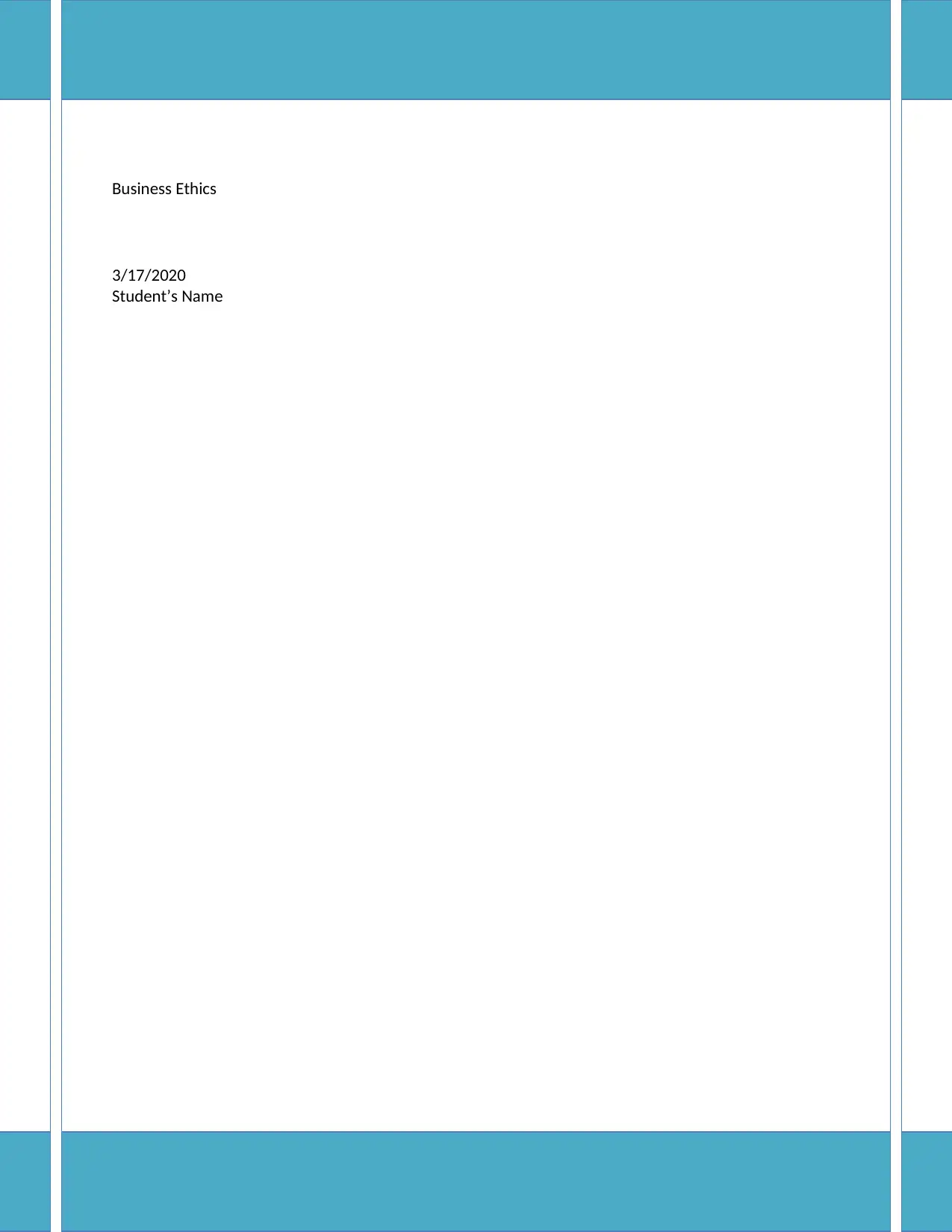
Running Head: BUSINESS AND CORPORATION LAW 0
Business Ethics
3/17/2020
Student’s Name
Business Ethics
3/17/2020
Student’s Name
Paraphrase This Document
Need a fresh take? Get an instant paraphrase of this document with our AI Paraphraser
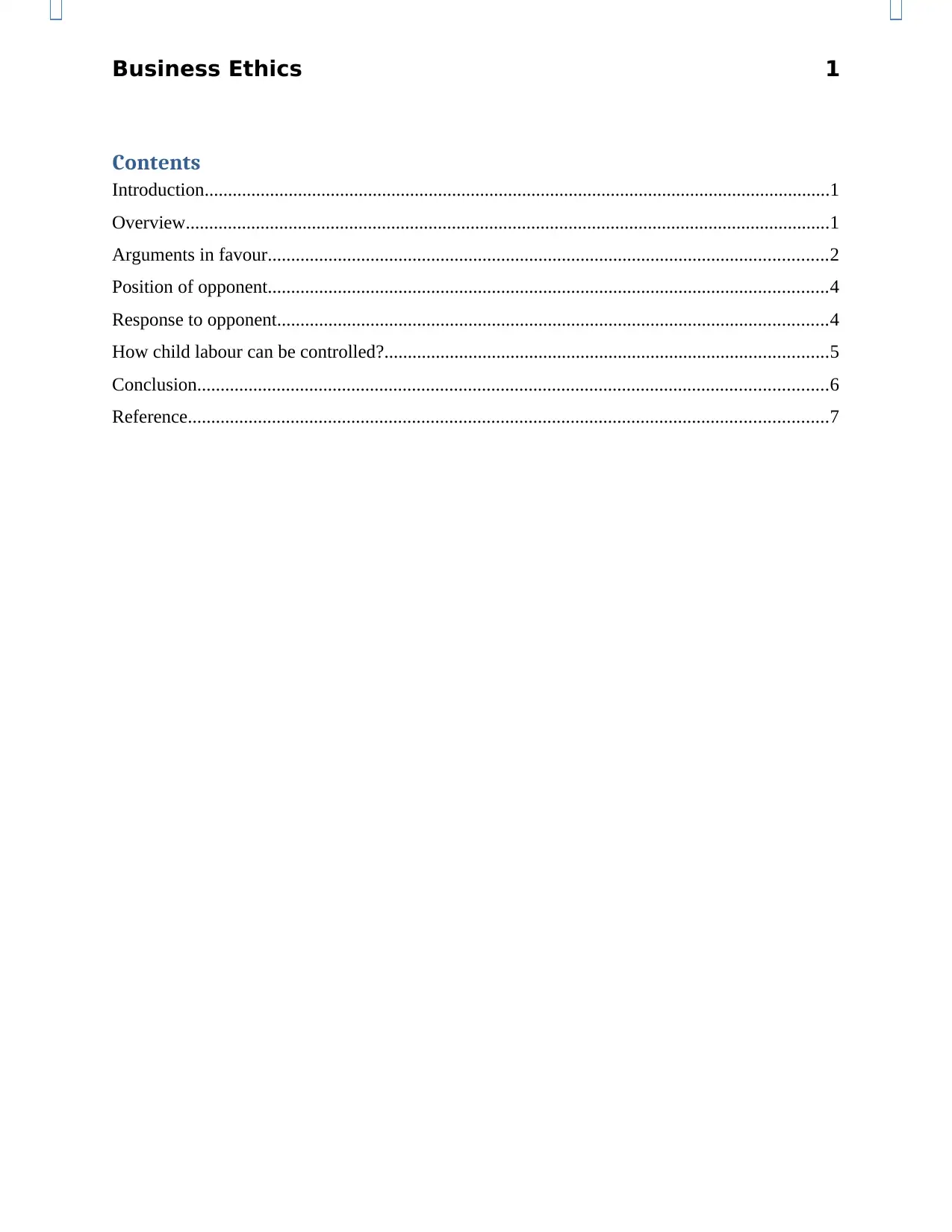
Business Ethics 1
Contents
Introduction......................................................................................................................................1
Overview..........................................................................................................................................1
Arguments in favour........................................................................................................................2
Position of opponent........................................................................................................................4
Response to opponent......................................................................................................................4
How child labour can be controlled?...............................................................................................5
Conclusion.......................................................................................................................................6
Reference.........................................................................................................................................7
Contents
Introduction......................................................................................................................................1
Overview..........................................................................................................................................1
Arguments in favour........................................................................................................................2
Position of opponent........................................................................................................................4
Response to opponent......................................................................................................................4
How child labour can be controlled?...............................................................................................5
Conclusion.......................................................................................................................................6
Reference.........................................................................................................................................7
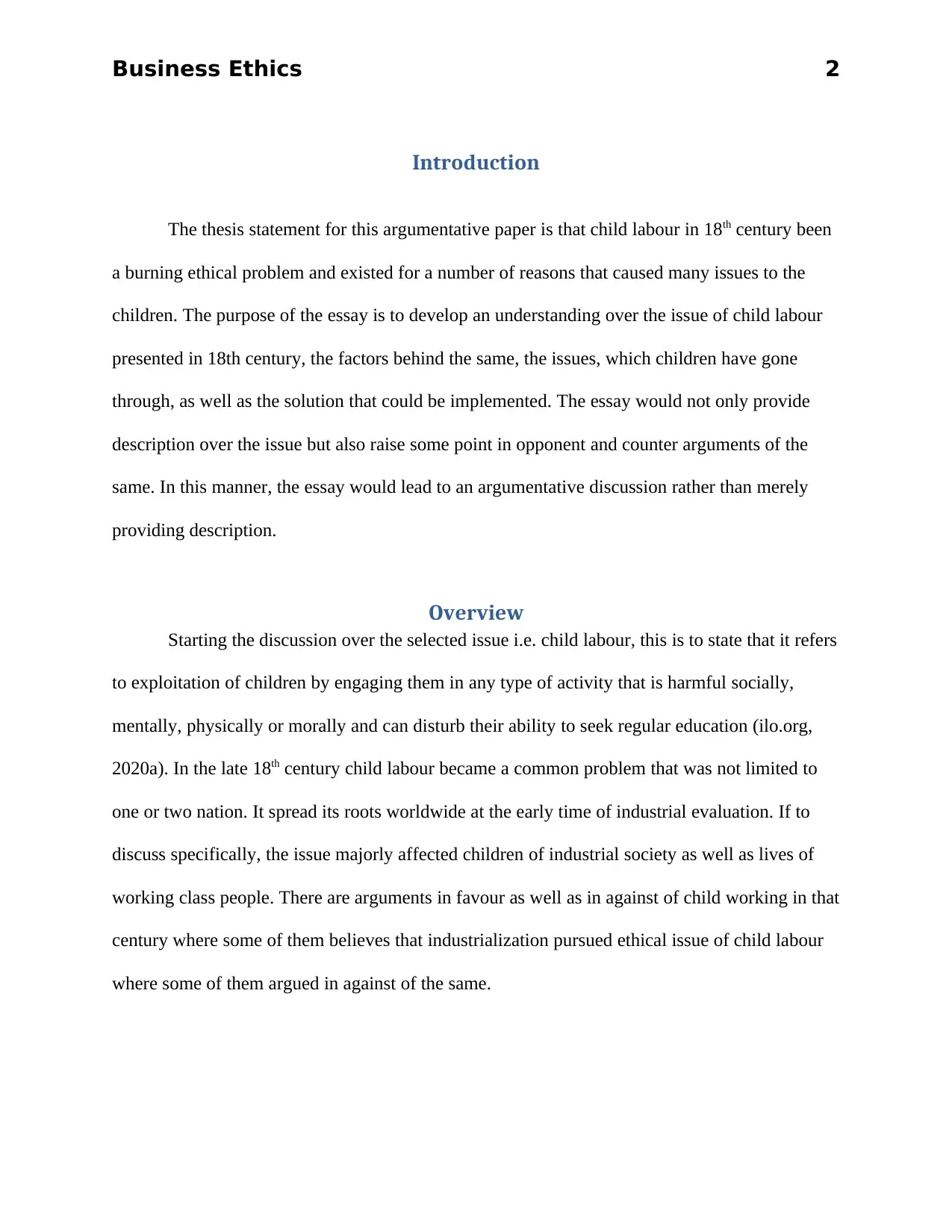
Business Ethics 2
Introduction
The thesis statement for this argumentative paper is that child labour in 18th century been
a burning ethical problem and existed for a number of reasons that caused many issues to the
children. The purpose of the essay is to develop an understanding over the issue of child labour
presented in 18th century, the factors behind the same, the issues, which children have gone
through, as well as the solution that could be implemented. The essay would not only provide
description over the issue but also raise some point in opponent and counter arguments of the
same. In this manner, the essay would lead to an argumentative discussion rather than merely
providing description.
Overview
Starting the discussion over the selected issue i.e. child labour, this is to state that it refers
to exploitation of children by engaging them in any type of activity that is harmful socially,
mentally, physically or morally and can disturb their ability to seek regular education (ilo.org,
2020a). In the late 18th century child labour became a common problem that was not limited to
one or two nation. It spread its roots worldwide at the early time of industrial evaluation. If to
discuss specifically, the issue majorly affected children of industrial society as well as lives of
working class people. There are arguments in favour as well as in against of child working in that
century where some of them believes that industrialization pursued ethical issue of child labour
where some of them argued in against of the same.
Introduction
The thesis statement for this argumentative paper is that child labour in 18th century been
a burning ethical problem and existed for a number of reasons that caused many issues to the
children. The purpose of the essay is to develop an understanding over the issue of child labour
presented in 18th century, the factors behind the same, the issues, which children have gone
through, as well as the solution that could be implemented. The essay would not only provide
description over the issue but also raise some point in opponent and counter arguments of the
same. In this manner, the essay would lead to an argumentative discussion rather than merely
providing description.
Overview
Starting the discussion over the selected issue i.e. child labour, this is to state that it refers
to exploitation of children by engaging them in any type of activity that is harmful socially,
mentally, physically or morally and can disturb their ability to seek regular education (ilo.org,
2020a). In the late 18th century child labour became a common problem that was not limited to
one or two nation. It spread its roots worldwide at the early time of industrial evaluation. If to
discuss specifically, the issue majorly affected children of industrial society as well as lives of
working class people. There are arguments in favour as well as in against of child working in that
century where some of them believes that industrialization pursued ethical issue of child labour
where some of them argued in against of the same.
⊘ This is a preview!⊘
Do you want full access?
Subscribe today to unlock all pages.

Trusted by 1+ million students worldwide
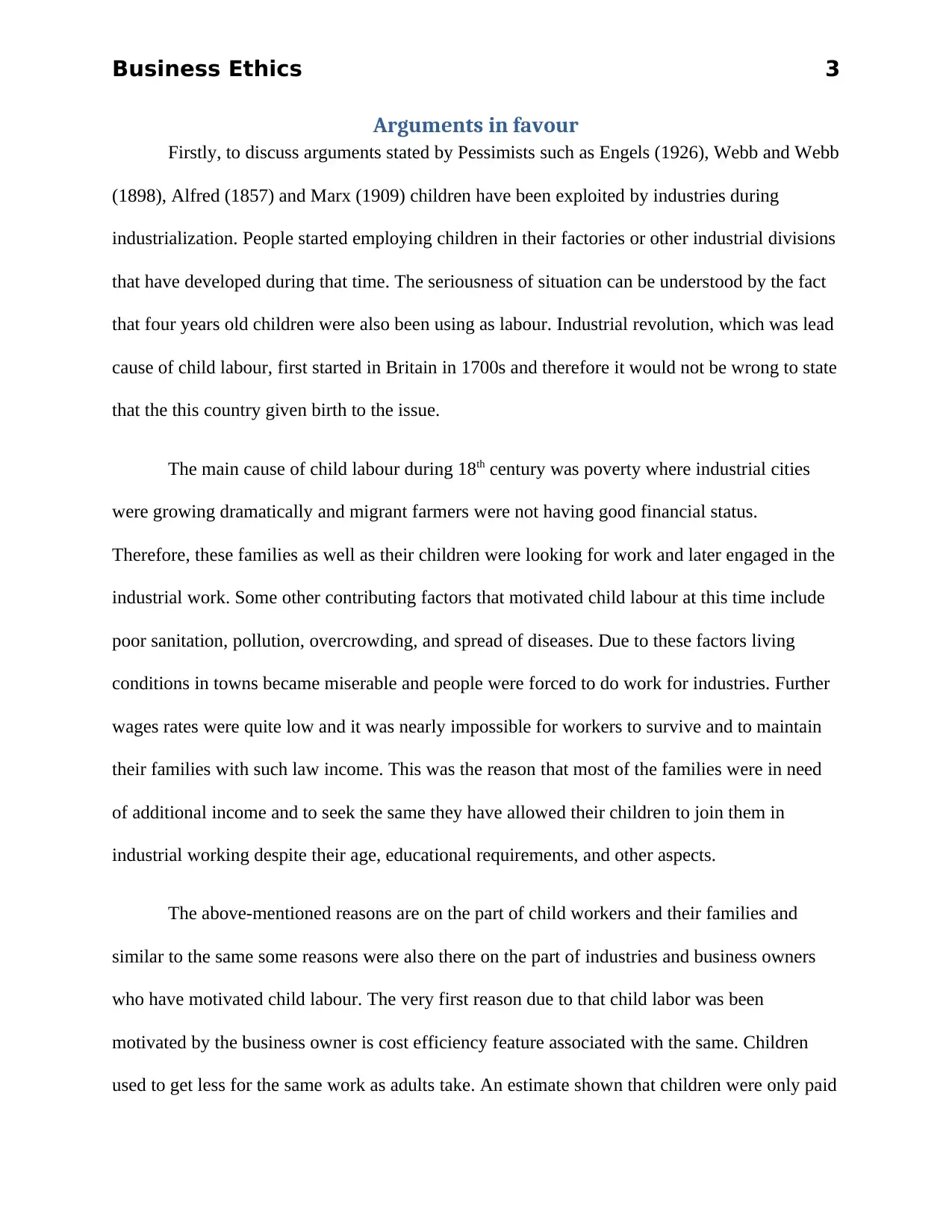
Business Ethics 3
Arguments in favour
Firstly, to discuss arguments stated by Pessimists such as Engels (1926), Webb and Webb
(1898), Alfred (1857) and Marx (1909) children have been exploited by industries during
industrialization. People started employing children in their factories or other industrial divisions
that have developed during that time. The seriousness of situation can be understood by the fact
that four years old children were also been using as labour. Industrial revolution, which was lead
cause of child labour, first started in Britain in 1700s and therefore it would not be wrong to state
that the this country given birth to the issue.
The main cause of child labour during 18th century was poverty where industrial cities
were growing dramatically and migrant farmers were not having good financial status.
Therefore, these families as well as their children were looking for work and later engaged in the
industrial work. Some other contributing factors that motivated child labour at this time include
poor sanitation, pollution, overcrowding, and spread of diseases. Due to these factors living
conditions in towns became miserable and people were forced to do work for industries. Further
wages rates were quite low and it was nearly impossible for workers to survive and to maintain
their families with such law income. This was the reason that most of the families were in need
of additional income and to seek the same they have allowed their children to join them in
industrial working despite their age, educational requirements, and other aspects.
The above-mentioned reasons are on the part of child workers and their families and
similar to the same some reasons were also there on the part of industries and business owners
who have motivated child labour. The very first reason due to that child labor was been
motivated by the business owner is cost efficiency feature associated with the same. Children
used to get less for the same work as adults take. An estimate shown that children were only paid
Arguments in favour
Firstly, to discuss arguments stated by Pessimists such as Engels (1926), Webb and Webb
(1898), Alfred (1857) and Marx (1909) children have been exploited by industries during
industrialization. People started employing children in their factories or other industrial divisions
that have developed during that time. The seriousness of situation can be understood by the fact
that four years old children were also been using as labour. Industrial revolution, which was lead
cause of child labour, first started in Britain in 1700s and therefore it would not be wrong to state
that the this country given birth to the issue.
The main cause of child labour during 18th century was poverty where industrial cities
were growing dramatically and migrant farmers were not having good financial status.
Therefore, these families as well as their children were looking for work and later engaged in the
industrial work. Some other contributing factors that motivated child labour at this time include
poor sanitation, pollution, overcrowding, and spread of diseases. Due to these factors living
conditions in towns became miserable and people were forced to do work for industries. Further
wages rates were quite low and it was nearly impossible for workers to survive and to maintain
their families with such law income. This was the reason that most of the families were in need
of additional income and to seek the same they have allowed their children to join them in
industrial working despite their age, educational requirements, and other aspects.
The above-mentioned reasons are on the part of child workers and their families and
similar to the same some reasons were also there on the part of industries and business owners
who have motivated child labour. The very first reason due to that child labor was been
motivated by the business owner is cost efficiency feature associated with the same. Children
used to get less for the same work as adults take. An estimate shown that children were only paid
Paraphrase This Document
Need a fresh take? Get an instant paraphrase of this document with our AI Paraphraser
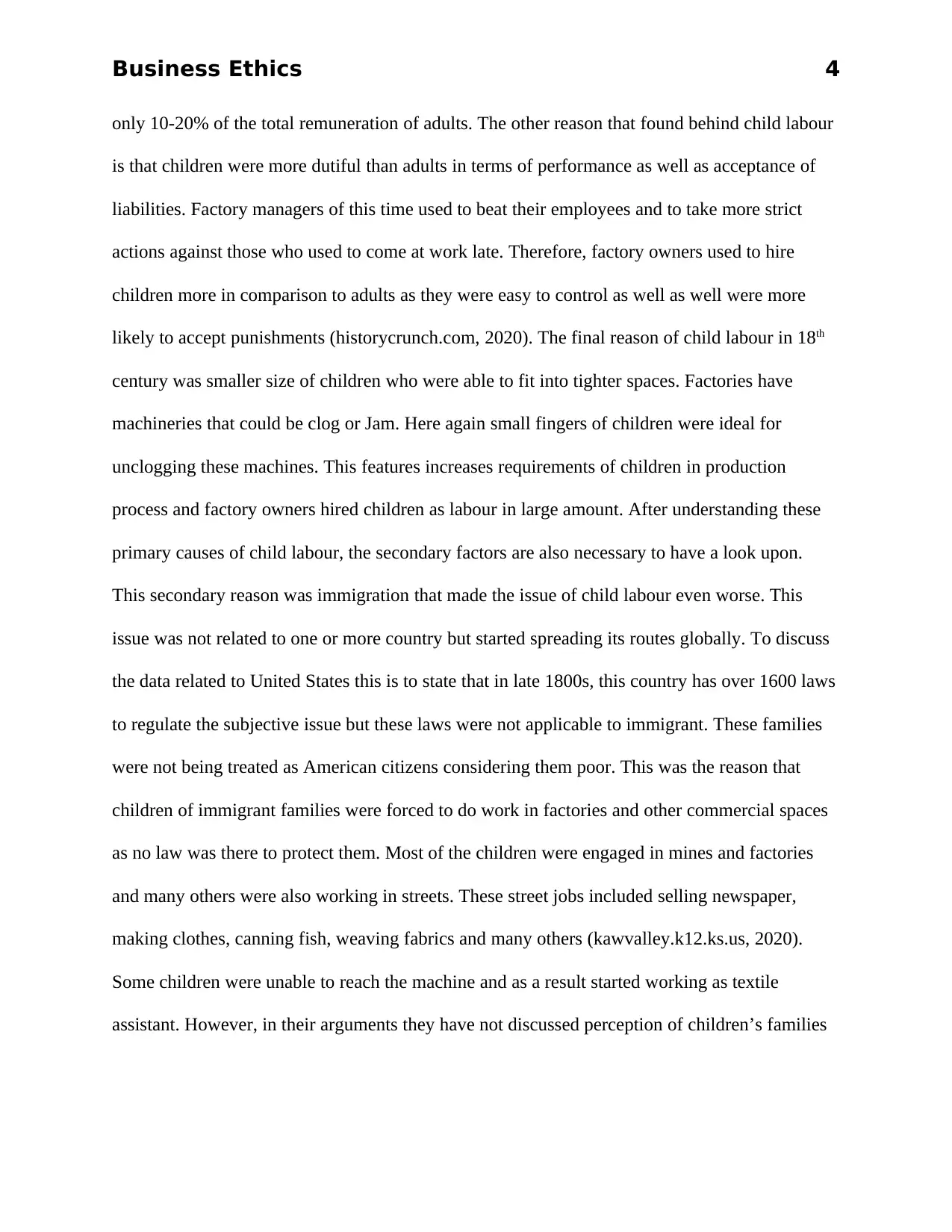
Business Ethics 4
only 10-20% of the total remuneration of adults. The other reason that found behind child labour
is that children were more dutiful than adults in terms of performance as well as acceptance of
liabilities. Factory managers of this time used to beat their employees and to take more strict
actions against those who used to come at work late. Therefore, factory owners used to hire
children more in comparison to adults as they were easy to control as well as well were more
likely to accept punishments (historycrunch.com, 2020). The final reason of child labour in 18th
century was smaller size of children who were able to fit into tighter spaces. Factories have
machineries that could be clog or Jam. Here again small fingers of children were ideal for
unclogging these machines. This features increases requirements of children in production
process and factory owners hired children as labour in large amount. After understanding these
primary causes of child labour, the secondary factors are also necessary to have a look upon.
This secondary reason was immigration that made the issue of child labour even worse. This
issue was not related to one or more country but started spreading its routes globally. To discuss
the data related to United States this is to state that in late 1800s, this country has over 1600 laws
to regulate the subjective issue but these laws were not applicable to immigrant. These families
were not being treated as American citizens considering them poor. This was the reason that
children of immigrant families were forced to do work in factories and other commercial spaces
as no law was there to protect them. Most of the children were engaged in mines and factories
and many others were also working in streets. These street jobs included selling newspaper,
making clothes, canning fish, weaving fabrics and many others (kawvalley.k12.ks.us, 2020).
Some children were unable to reach the machine and as a result started working as textile
assistant. However, in their arguments they have not discussed perception of children’s families
only 10-20% of the total remuneration of adults. The other reason that found behind child labour
is that children were more dutiful than adults in terms of performance as well as acceptance of
liabilities. Factory managers of this time used to beat their employees and to take more strict
actions against those who used to come at work late. Therefore, factory owners used to hire
children more in comparison to adults as they were easy to control as well as well were more
likely to accept punishments (historycrunch.com, 2020). The final reason of child labour in 18th
century was smaller size of children who were able to fit into tighter spaces. Factories have
machineries that could be clog or Jam. Here again small fingers of children were ideal for
unclogging these machines. This features increases requirements of children in production
process and factory owners hired children as labour in large amount. After understanding these
primary causes of child labour, the secondary factors are also necessary to have a look upon.
This secondary reason was immigration that made the issue of child labour even worse. This
issue was not related to one or more country but started spreading its routes globally. To discuss
the data related to United States this is to state that in late 1800s, this country has over 1600 laws
to regulate the subjective issue but these laws were not applicable to immigrant. These families
were not being treated as American citizens considering them poor. This was the reason that
children of immigrant families were forced to do work in factories and other commercial spaces
as no law was there to protect them. Most of the children were engaged in mines and factories
and many others were also working in streets. These street jobs included selling newspaper,
making clothes, canning fish, weaving fabrics and many others (kawvalley.k12.ks.us, 2020).
Some children were unable to reach the machine and as a result started working as textile
assistant. However, in their arguments they have not discussed perception of children’s families
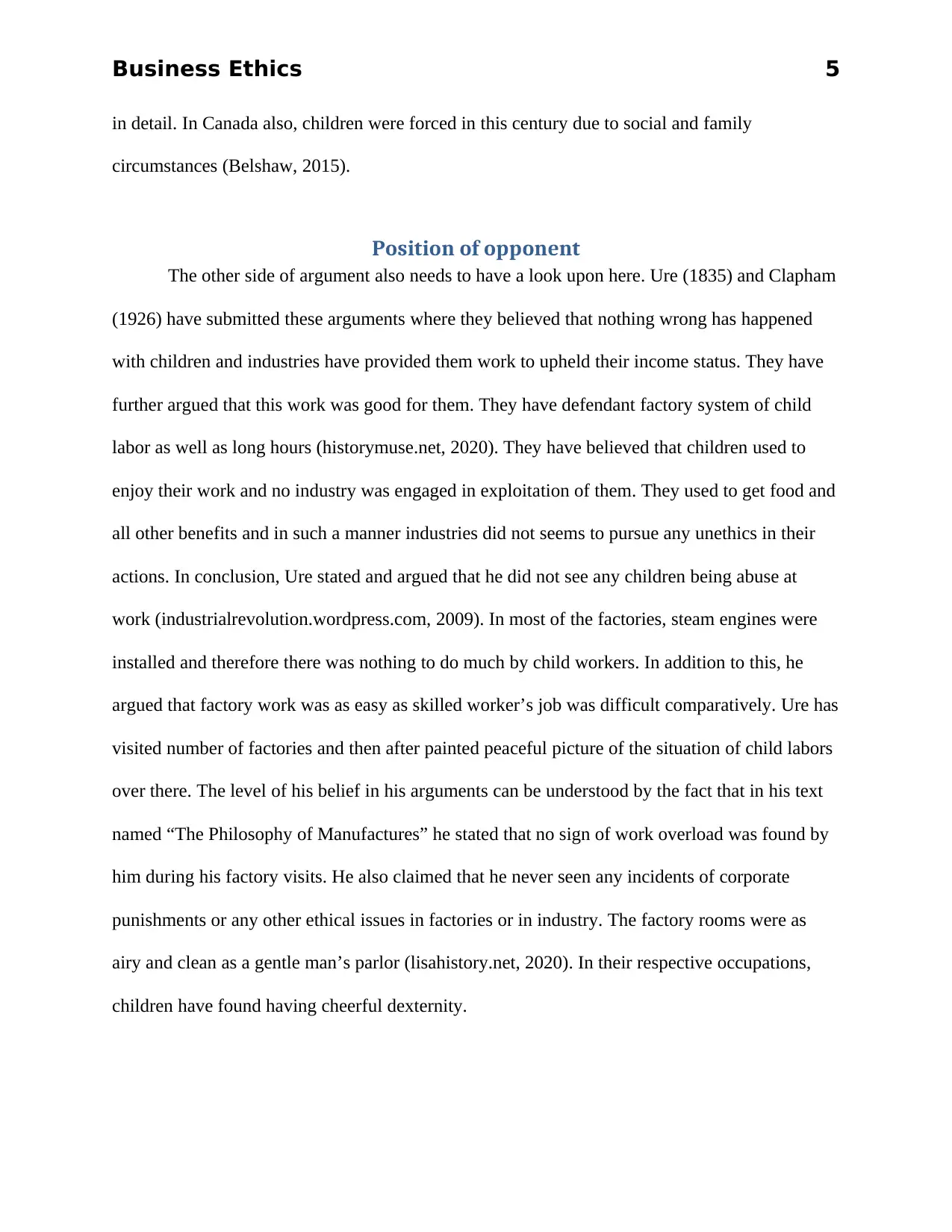
Business Ethics 5
in detail. In Canada also, children were forced in this century due to social and family
circumstances (Belshaw, 2015).
Position of opponent
The other side of argument also needs to have a look upon here. Ure (1835) and Clapham
(1926) have submitted these arguments where they believed that nothing wrong has happened
with children and industries have provided them work to upheld their income status. They have
further argued that this work was good for them. They have defendant factory system of child
labor as well as long hours (historymuse.net, 2020). They have believed that children used to
enjoy their work and no industry was engaged in exploitation of them. They used to get food and
all other benefits and in such a manner industries did not seems to pursue any unethics in their
actions. In conclusion, Ure stated and argued that he did not see any children being abuse at
work (industrialrevolution.wordpress.com, 2009). In most of the factories, steam engines were
installed and therefore there was nothing to do much by child workers. In addition to this, he
argued that factory work was as easy as skilled worker’s job was difficult comparatively. Ure has
visited number of factories and then after painted peaceful picture of the situation of child labors
over there. The level of his belief in his arguments can be understood by the fact that in his text
named “The Philosophy of Manufactures” he stated that no sign of work overload was found by
him during his factory visits. He also claimed that he never seen any incidents of corporate
punishments or any other ethical issues in factories or in industry. The factory rooms were as
airy and clean as a gentle man’s parlor (lisahistory.net, 2020). In their respective occupations,
children have found having cheerful dexternity.
in detail. In Canada also, children were forced in this century due to social and family
circumstances (Belshaw, 2015).
Position of opponent
The other side of argument also needs to have a look upon here. Ure (1835) and Clapham
(1926) have submitted these arguments where they believed that nothing wrong has happened
with children and industries have provided them work to upheld their income status. They have
further argued that this work was good for them. They have defendant factory system of child
labor as well as long hours (historymuse.net, 2020). They have believed that children used to
enjoy their work and no industry was engaged in exploitation of them. They used to get food and
all other benefits and in such a manner industries did not seems to pursue any unethics in their
actions. In conclusion, Ure stated and argued that he did not see any children being abuse at
work (industrialrevolution.wordpress.com, 2009). In most of the factories, steam engines were
installed and therefore there was nothing to do much by child workers. In addition to this, he
argued that factory work was as easy as skilled worker’s job was difficult comparatively. Ure has
visited number of factories and then after painted peaceful picture of the situation of child labors
over there. The level of his belief in his arguments can be understood by the fact that in his text
named “The Philosophy of Manufactures” he stated that no sign of work overload was found by
him during his factory visits. He also claimed that he never seen any incidents of corporate
punishments or any other ethical issues in factories or in industry. The factory rooms were as
airy and clean as a gentle man’s parlor (lisahistory.net, 2020). In their respective occupations,
children have found having cheerful dexternity.
⊘ This is a preview!⊘
Do you want full access?
Subscribe today to unlock all pages.

Trusted by 1+ million students worldwide
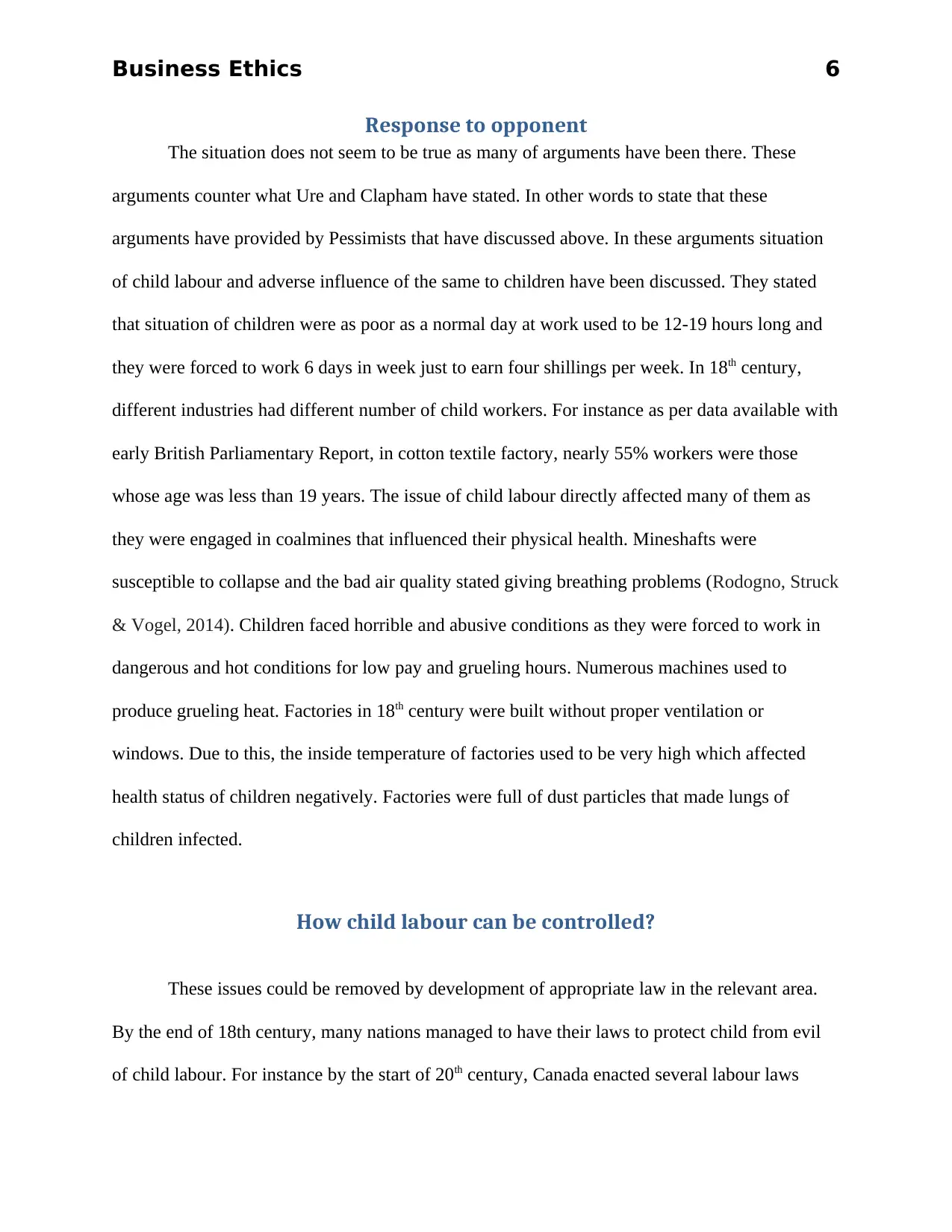
Business Ethics 6
Response to opponent
The situation does not seem to be true as many of arguments have been there. These
arguments counter what Ure and Clapham have stated. In other words to state that these
arguments have provided by Pessimists that have discussed above. In these arguments situation
of child labour and adverse influence of the same to children have been discussed. They stated
that situation of children were as poor as a normal day at work used to be 12-19 hours long and
they were forced to work 6 days in week just to earn four shillings per week. In 18th century,
different industries had different number of child workers. For instance as per data available with
early British Parliamentary Report, in cotton textile factory, nearly 55% workers were those
whose age was less than 19 years. The issue of child labour directly affected many of them as
they were engaged in coalmines that influenced their physical health. Mineshafts were
susceptible to collapse and the bad air quality stated giving breathing problems (Rodogno, Struck
& Vogel, 2014). Children faced horrible and abusive conditions as they were forced to work in
dangerous and hot conditions for low pay and grueling hours. Numerous machines used to
produce grueling heat. Factories in 18th century were built without proper ventilation or
windows. Due to this, the inside temperature of factories used to be very high which affected
health status of children negatively. Factories were full of dust particles that made lungs of
children infected.
How child labour can be controlled?
These issues could be removed by development of appropriate law in the relevant area.
By the end of 18th century, many nations managed to have their laws to protect child from evil
of child labour. For instance by the start of 20th century, Canada enacted several labour laws
Response to opponent
The situation does not seem to be true as many of arguments have been there. These
arguments counter what Ure and Clapham have stated. In other words to state that these
arguments have provided by Pessimists that have discussed above. In these arguments situation
of child labour and adverse influence of the same to children have been discussed. They stated
that situation of children were as poor as a normal day at work used to be 12-19 hours long and
they were forced to work 6 days in week just to earn four shillings per week. In 18th century,
different industries had different number of child workers. For instance as per data available with
early British Parliamentary Report, in cotton textile factory, nearly 55% workers were those
whose age was less than 19 years. The issue of child labour directly affected many of them as
they were engaged in coalmines that influenced their physical health. Mineshafts were
susceptible to collapse and the bad air quality stated giving breathing problems (Rodogno, Struck
& Vogel, 2014). Children faced horrible and abusive conditions as they were forced to work in
dangerous and hot conditions for low pay and grueling hours. Numerous machines used to
produce grueling heat. Factories in 18th century were built without proper ventilation or
windows. Due to this, the inside temperature of factories used to be very high which affected
health status of children negatively. Factories were full of dust particles that made lungs of
children infected.
How child labour can be controlled?
These issues could be removed by development of appropriate law in the relevant area.
By the end of 18th century, many nations managed to have their laws to protect child from evil
of child labour. For instance by the start of 20th century, Canada enacted several labour laws
Paraphrase This Document
Need a fresh take? Get an instant paraphrase of this document with our AI Paraphraser
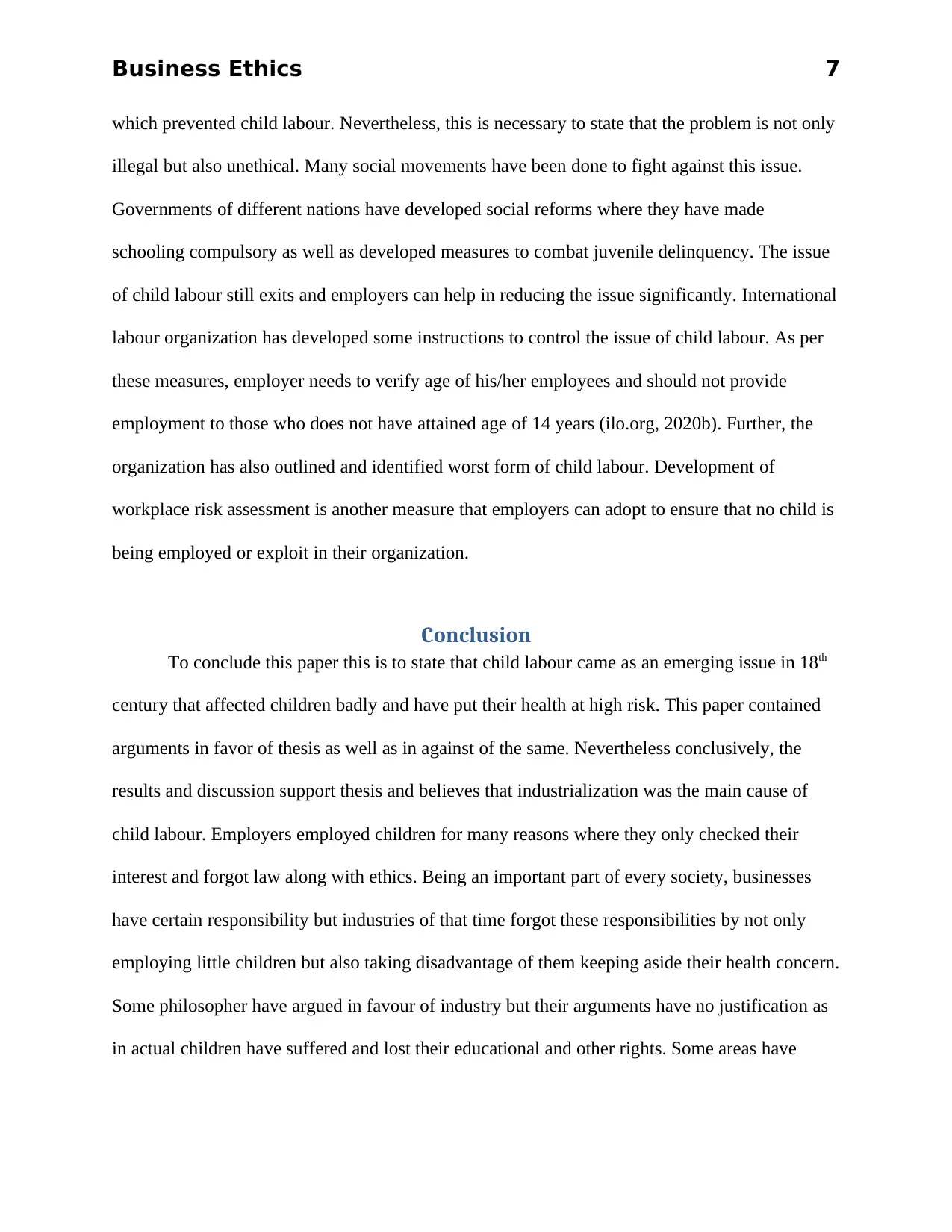
Business Ethics 7
which prevented child labour. Nevertheless, this is necessary to state that the problem is not only
illegal but also unethical. Many social movements have been done to fight against this issue.
Governments of different nations have developed social reforms where they have made
schooling compulsory as well as developed measures to combat juvenile delinquency. The issue
of child labour still exits and employers can help in reducing the issue significantly. International
labour organization has developed some instructions to control the issue of child labour. As per
these measures, employer needs to verify age of his/her employees and should not provide
employment to those who does not have attained age of 14 years (ilo.org, 2020b). Further, the
organization has also outlined and identified worst form of child labour. Development of
workplace risk assessment is another measure that employers can adopt to ensure that no child is
being employed or exploit in their organization.
Conclusion
To conclude this paper this is to state that child labour came as an emerging issue in 18th
century that affected children badly and have put their health at high risk. This paper contained
arguments in favor of thesis as well as in against of the same. Nevertheless conclusively, the
results and discussion support thesis and believes that industrialization was the main cause of
child labour. Employers employed children for many reasons where they only checked their
interest and forgot law along with ethics. Being an important part of every society, businesses
have certain responsibility but industries of that time forgot these responsibilities by not only
employing little children but also taking disadvantage of them keeping aside their health concern.
Some philosopher have argued in favour of industry but their arguments have no justification as
in actual children have suffered and lost their educational and other rights. Some areas have
which prevented child labour. Nevertheless, this is necessary to state that the problem is not only
illegal but also unethical. Many social movements have been done to fight against this issue.
Governments of different nations have developed social reforms where they have made
schooling compulsory as well as developed measures to combat juvenile delinquency. The issue
of child labour still exits and employers can help in reducing the issue significantly. International
labour organization has developed some instructions to control the issue of child labour. As per
these measures, employer needs to verify age of his/her employees and should not provide
employment to those who does not have attained age of 14 years (ilo.org, 2020b). Further, the
organization has also outlined and identified worst form of child labour. Development of
workplace risk assessment is another measure that employers can adopt to ensure that no child is
being employed or exploit in their organization.
Conclusion
To conclude this paper this is to state that child labour came as an emerging issue in 18th
century that affected children badly and have put their health at high risk. This paper contained
arguments in favor of thesis as well as in against of the same. Nevertheless conclusively, the
results and discussion support thesis and believes that industrialization was the main cause of
child labour. Employers employed children for many reasons where they only checked their
interest and forgot law along with ethics. Being an important part of every society, businesses
have certain responsibility but industries of that time forgot these responsibilities by not only
employing little children but also taking disadvantage of them keeping aside their health concern.
Some philosopher have argued in favour of industry but their arguments have no justification as
in actual children have suffered and lost their educational and other rights. Some areas have

Business Ethics 8
leave uncovered here such as family perception, actions of particular government, particular
cases of child and so on which need to be explored by further research.
leave uncovered here such as family perception, actions of particular government, particular
cases of child and so on which need to be explored by further research.
⊘ This is a preview!⊘
Do you want full access?
Subscribe today to unlock all pages.

Trusted by 1+ million students worldwide
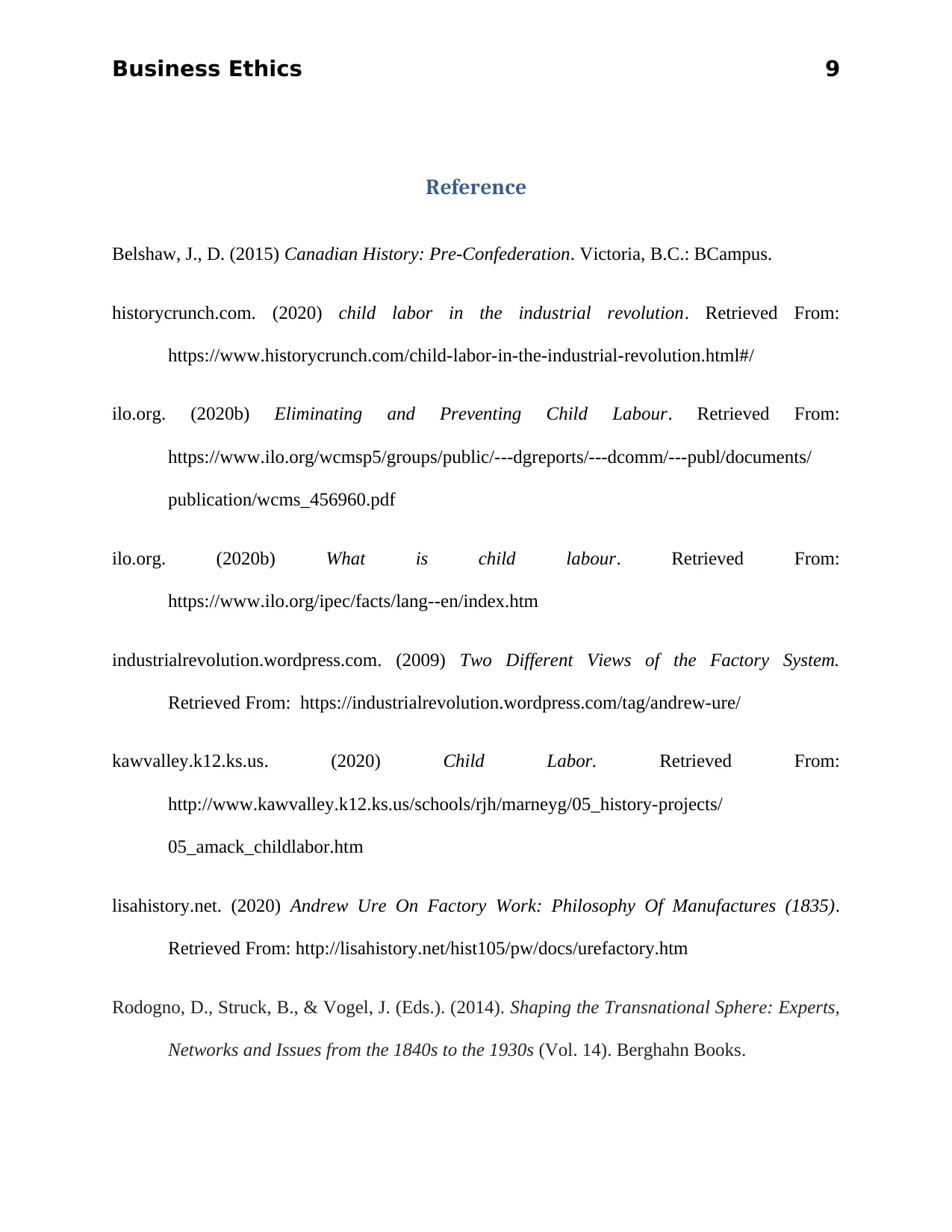
Business Ethics 9
Reference
Belshaw, J., D. (2015) Canadian History: Pre-Confederation. Victoria, B.C.: BCampus.
historycrunch.com. (2020) child labor in the industrial revolution. Retrieved From:
https://www.historycrunch.com/child-labor-in-the-industrial-revolution.html#/
ilo.org. (2020b) Eliminating and Preventing Child Labour. Retrieved From:
https://www.ilo.org/wcmsp5/groups/public/---dgreports/---dcomm/---publ/documents/
publication/wcms_456960.pdf
ilo.org. (2020b) What is child labour. Retrieved From:
https://www.ilo.org/ipec/facts/lang--en/index.htm
industrialrevolution.wordpress.com. (2009) Two Different Views of the Factory System.
Retrieved From: https://industrialrevolution.wordpress.com/tag/andrew-ure/
kawvalley.k12.ks.us. (2020) Child Labor. Retrieved From:
http://www.kawvalley.k12.ks.us/schools/rjh/marneyg/05_history-projects/
05_amack_childlabor.htm
lisahistory.net. (2020) Andrew Ure On Factory Work: Philosophy Of Manufactures (1835).
Retrieved From: http://lisahistory.net/hist105/pw/docs/urefactory.htm
Rodogno, D., Struck, B., & Vogel, J. (Eds.). (2014). Shaping the Transnational Sphere: Experts,
Networks and Issues from the 1840s to the 1930s (Vol. 14). Berghahn Books.
Reference
Belshaw, J., D. (2015) Canadian History: Pre-Confederation. Victoria, B.C.: BCampus.
historycrunch.com. (2020) child labor in the industrial revolution. Retrieved From:
https://www.historycrunch.com/child-labor-in-the-industrial-revolution.html#/
ilo.org. (2020b) Eliminating and Preventing Child Labour. Retrieved From:
https://www.ilo.org/wcmsp5/groups/public/---dgreports/---dcomm/---publ/documents/
publication/wcms_456960.pdf
ilo.org. (2020b) What is child labour. Retrieved From:
https://www.ilo.org/ipec/facts/lang--en/index.htm
industrialrevolution.wordpress.com. (2009) Two Different Views of the Factory System.
Retrieved From: https://industrialrevolution.wordpress.com/tag/andrew-ure/
kawvalley.k12.ks.us. (2020) Child Labor. Retrieved From:
http://www.kawvalley.k12.ks.us/schools/rjh/marneyg/05_history-projects/
05_amack_childlabor.htm
lisahistory.net. (2020) Andrew Ure On Factory Work: Philosophy Of Manufactures (1835).
Retrieved From: http://lisahistory.net/hist105/pw/docs/urefactory.htm
Rodogno, D., Struck, B., & Vogel, J. (Eds.). (2014). Shaping the Transnational Sphere: Experts,
Networks and Issues from the 1840s to the 1930s (Vol. 14). Berghahn Books.
Paraphrase This Document
Need a fresh take? Get an instant paraphrase of this document with our AI Paraphraser
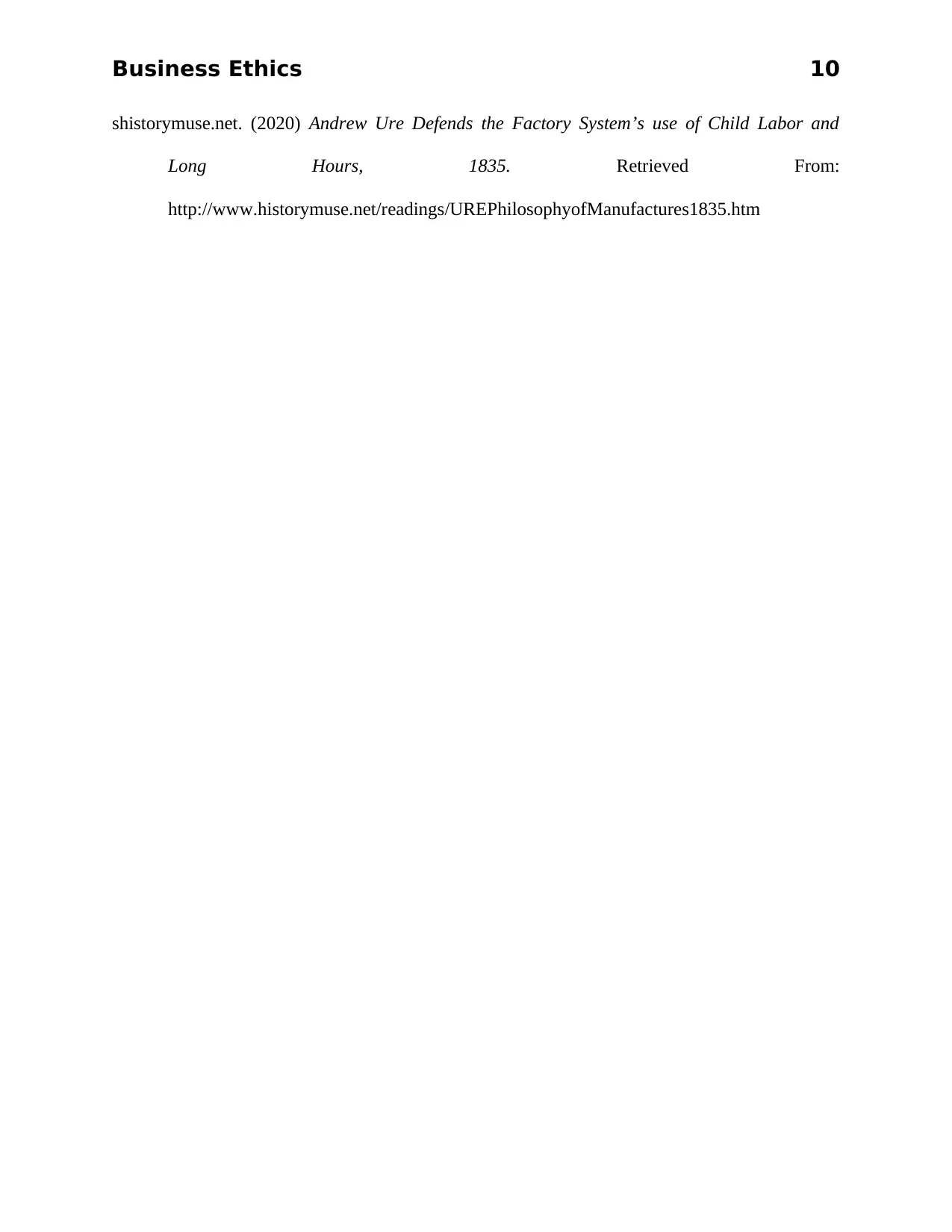
Business Ethics 10
shistorymuse.net. (2020) Andrew Ure Defends the Factory System’s use of Child Labor and
Long Hours, 1835. Retrieved From:
http://www.historymuse.net/readings/UREPhilosophyofManufactures1835.htm
shistorymuse.net. (2020) Andrew Ure Defends the Factory System’s use of Child Labor and
Long Hours, 1835. Retrieved From:
http://www.historymuse.net/readings/UREPhilosophyofManufactures1835.htm
1 out of 11
Related Documents
Your All-in-One AI-Powered Toolkit for Academic Success.
+13062052269
info@desklib.com
Available 24*7 on WhatsApp / Email
![[object Object]](/_next/static/media/star-bottom.7253800d.svg)
Unlock your academic potential
Copyright © 2020–2025 A2Z Services. All Rights Reserved. Developed and managed by ZUCOL.





